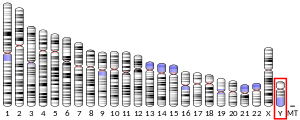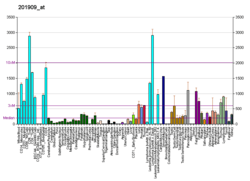40S ribosomal protein S4, Y isoform 1
40S ribosomal protein S4, Y isoform 1 is a protein that in humans is encoded by the RPS4Y1 gene.[5][6][7]
Cytoplasmic ribosomes, organelles that catalyze protein synthesis, consist of a small 40S subunit and a large 60S subunit. Together these subunits are composed of 4 RNA species and approximately 80 structurally distinct proteins. This gene encodes ribosomal protein S4, a component of the 40S subunit. Ribosomal protein S4 is the only ribosomal protein known to be encoded by more than one gene, namely this gene, RPS4Y2 and the ribosomal protein S4, X-linked (RPS4X). The 3 isoforms encoded by these genes are not identical, but appear to be functionally equivalent.[8] Ribosomal protein S4 belongs to the S4E family of ribosomal proteins. It has been suggested that haploinsufficiency of the ribosomal protein S4 genes plays a role in Turner syndrome; however, this hypothesis is controversial.[5]
References
- 1 2 3 GRCh38: Ensembl release 89: ENSG00000129824 - Ensembl, May 2017
- 1 2 3 GRCm38: Ensembl release 89: ENSMUSG00000031320 - Ensembl, May 2017
- ↑ "Human PubMed Reference:".
- ↑ "Mouse PubMed Reference:".
- 1 2 "Entrez Gene: RPS4Y1 ribosomal protein S4, Y-linked 1".
- ↑ Fisher EM, Beer-Romero P, Brown LG, Ridley A, McNeil JA, Lawrence JB, Willard HF, Bieber FR, Page DC (December 1990). "Homologous ribosomal protein genes on the human X and Y chromosomes: escape from X inactivation and possible implications for Turner syndrome". Cell. 63 (6): 1205–18. doi:10.1016/0092-8674(90)90416-C. PMID 2124517.
- ↑ Kenmochi N, Kawaguchi T, Rozen S, Davis E, Goodman N, Hudson TJ, Tanaka T, Page DC (May 1998). "A map of 75 human ribosomal protein genes". Genome Res. 8 (5): 509–23. doi:10.1101/gr.8.5.509. PMID 9582194.
- ↑ Andrés O, Kellermann T, López-Giráldez F, Rozas J, Domingo-Roura X, Bosch M (2008). "RPS4Y gene family evolution in primates". BMC Evol. Biol. 8: 142. doi:10.1186/1471-2148-8-142. PMC 2397393. PMID 18477388.
Further reading
- Wool IG, Chan YL, Glück A (1996). "Structure and evolution of mammalian ribosomal proteins". Biochem. Cell Biol. 73 (11–12): 933–47. doi:10.1139/o95-101. PMID 8722009.
- Fisher EM, Beer-Romero P, Brown LG, et al. (1991). "Homologous ribosomal protein genes on the human X and Y chromosomes: escape from X inactivation and possible implications for Turner syndrome". Cell. 63 (6): 1205–18. doi:10.1016/0092-8674(90)90416-C. PMID 2124517.
- Weller PA, Critcher R, Goodfellow PN, et al. (1995). "The human Y chromosome homologue of XG: transcription of a naturally truncated gene". Hum. Mol. Genet. 4 (5): 859–68. doi:10.1093/hmg/4.5.859. PMID 7633446.
- Maruyama K, Sugano S (1994). "Oligo-capping: a simple method to replace the cap structure of eukaryotic mRNAs with oligoribonucleotides". Gene. 138 (1–2): 171–4. doi:10.1016/0378-1119(94)90802-8. PMID 8125298.
- Zinn AR, Alagappan RK, Brown LG, et al. (1994). "Structure and function of ribosomal protein S4 genes on the human and mouse sex chromosomes". Mol. Cell. Biol. 14 (4): 2485–92. doi:10.1128/mcb.14.4.2485. PMC 358616. PMID 8139551.
- Watanabe M, Zinn AR, Page DC, Nishimoto T (1993). "Functional equivalence of human X- and Y-encoded isoforms of ribosomal protein S4 consistent with a role in Turner syndrome". Nat. Genet. 4 (3): 268–71. doi:10.1038/ng0793-268. PMID 8358435.
- Vladimirov SN, Ivanov AV, Karpova GG, et al. (1996). "Characterization of the human small-ribosomal-subunit proteins by N-terminal and internal sequencing, and mass spectrometry". Eur. J. Biochem. 239 (1): 144–9. doi:10.1111/j.1432-1033.1996.0144u.x. PMID 8706699.
- Omoe K, Endo A (1996). "Relationship between the monosomy X phenotype and Y-linked ribosomal protein S4 (Rps4) in several species of mammals: a molecular evolutionary analysis of Rps4 homologs". Genomics. 31 (1): 44–50. doi:10.1006/geno.1996.0007. PMID 8808278.
- Suzuki Y, Yoshitomo-Nakagawa K, Maruyama K, et al. (1997). "Construction and characterization of a full length-enriched and a 5'-end-enriched cDNA library". Gene. 200 (1–2): 149–56. doi:10.1016/S0378-1119(97)00411-3. PMID 9373149.
- Kenmochi N, Kawaguchi T, Rozen S, et al. (1998). "A map of 75 human ribosomal protein genes". Genome Res. 8 (5): 509–23. doi:10.1101/gr.8.5.509. PMID 9582194.
- Uechi T, Tanaka T, Kenmochi N (2001). "A complete map of the human ribosomal protein genes: assignment of 80 genes to the cytogenetic map and implications for human disorders". Genomics. 72 (3): 223–30. doi:10.1006/geno.2000.6470. PMID 11401437.
- Bakay M, Zhao P, Chen J, Hoffman EP (2002). "A web-accessible complete transcriptome of normal human and DMD muscle". Neuromuscul. Disord. 12. Suppl 1: S125–41. doi:10.1016/S0960-8966(02)00093-7. PMID 12206807.
- Strausberg RL, Feingold EA, Grouse LH, et al. (2003). "Generation and initial analysis of more than 15,000 full-length human and mouse cDNA sequences". Proc. Natl. Acad. Sci. U.S.A. 99 (26): 16899–903. doi:10.1073/pnas.242603899. PMC 139241. PMID 12477932.
- Skaletsky H, Kuroda-Kawaguchi T, Minx PJ, et al. (2003). "The male-specific region of the human Y chromosome is a mosaic of discrete sequence classes". Nature. 423 (6942): 825–37. doi:10.1038/nature01722. PMID 12815422.
- Vawter MP, Evans S, Choudary P, et al. (2004). "Gender-specific gene expression in post-mortem human brain: localization to sex chromosomes". Neuropsychopharmacology. 29 (2): 373–84. doi:10.1038/sj.npp.1300337. PMC 3130534. PMID 14583743.
- Agate RJ, Choe M, Arnold AP (2004). "Sex differences in structure and expression of the sex chromosome genes CHD1Z and CHD1W in zebra finches". Mol. Biol. Evol. 21 (2): 384–96. doi:10.1093/molbev/msh027. PMID 14660691.
- Gerhard DS, Wagner L, Feingold EA, et al. (2004). "The status, quality, and expansion of the NIH full-length cDNA project: the Mammalian Gene Collection (MGC)". Genome Res. 14 (10B): 2121–7. doi:10.1101/gr.2596504. PMC 528928. PMID 15489334.




